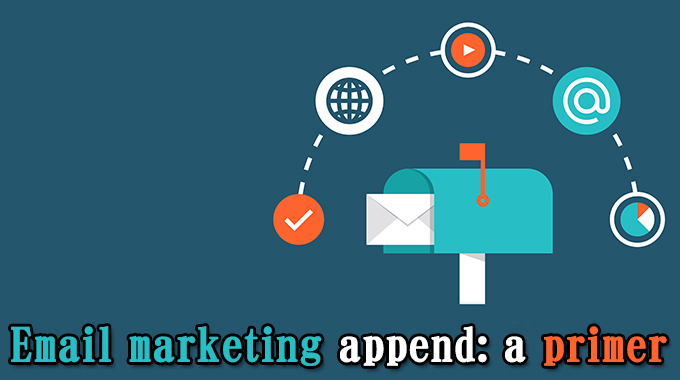Email marketing append: a primer

Email marketing append is often sold as a quick way to grow your email list. But it’s important to look at the pros and cons before you move forward. Here’s a primer along with some tips.
Appending defined
Appending is the act of having a third-party match new data fields to your existing customer or prospect file.
In the email world, the most common type of append is an email append; you provide your list of customer names and postal addresses and the vendor returns the file to you with email addresses attached.
You can also append other information, like household income, children in the home and age in the B2C world. In the B2B world you might want to append industry codes, revenue or other information.
For the purpose of his article, we’re going to focus on email appends.
Logistics of an append
Most people have more than one email address. Vendors typically offer you personal and/or business email addresses for an individual; you can also choose to do a ‘household match’ in the B2C world, meaning that the email address belongs to someone in the household (but not necessarily the actual individual in your database).
As you can imagine, household appends aren’t as precise as personal or business address appends. There’s a larger margin of error.
No matter which type of email addresses you request, it’s unlikely that any vendor will be able to successfully match 100% of your list. A 50% match is more likely; anything above 50% is really good.
So if you have 40,000 people on your list, it’s likely that a vendor will be able to provide email addresses for 20,000 of them. But that’s not necessarily how many names you’ll end up with.
Many vendors have very high hard bounce rates on their lists. List attribution is estimated to be about 30% annually, so this isn’t a surprise.
One vendor quoted an average 25% hard bounce rate on its first sends, meaning that those 20,000 email addresses will likely be only 15,000 after the first send.
Cost
Appends are a quick way to grow your email list, but they aren’t necessarily an inexpensive one.
The latest pricing I am privy to is $160 per thousand for personal or household email addresses; $400 per thousand for business email addresses.
So those 15,000 email addresses will cost you between $2,400 and $6,000. Not a king’s ransom but also not a small amount, especially for a small business.
Permission
Most vendors use a negative option opt-out, instead of an opt-in, model for permission. This means that they send an email message (some send two or three) to the email addresses they’ve matched to your file.
Recipients get the option to respond so that their email addresses aren’t shared with you; but if they do not respond permission is assumed. So if the email goes into the spam folder and the recipient never sees it, that’s assumed to be permission.
If you’re working with a mainstream email service provider (ESP) or marketing automation platform(MAP) this may be a stopper.
While this type of permission is legal in the United States (note: I’m not a lawyer but it’s my understanding that this does not constitute permission in Canada or most of the European countries), it typically does not meet the ‘opt-in’ criteria required by most mainstream ESPs and MAPs.
They require opt-in permission to protect their IP addresses from being blacklisted. And appended lists are a concern because without opt-in permission there is a higher risk of spam complaints.
So it’s possible that you’ll append these names and then not be able to send to them, at least not from the ESP or MAP that you use for your other marketing sends.
So what can you do? You can ask your append vendor to run an opt-in permission program for you instead of a negative option opt-out. Some will do it, some will not. If they will do it, the cost per thousand email addresses will increase dramatically. And your net email addresses coming out of the append will be less.
20% is a good benchmark for response to a permission request. You usually have 20% or fewer people opt-out of receiving email. But with an opt-in, you typically have 20% or fewer people that opt-in.
So from a list of 15,000 names a negative option opt-out will leave you with 12,000 or more email addresses to add to your database. An opt-in on a list of 15,000 will typically leave you with 3,000 or fewer net new email addresses on your file.
The level of connection that the people whose email addresses are being appended have with your brand plays a large role in the permission process. The more they like you, the higher your net addresses will be, no matter which permission model you use.
Performance
A lot of people focus on the size of their email list; but I would rather have a lower quantity, high quality list than a higher quantity, lower quality list. I’ve seen appends that generated a lot of new email addresses that rarely or never open or click on an email.
This is the downside to appends – if they don’t engage with you the money spent could all be for naught.
And low or no performance is definitely a possibility when you append email addresses. I’ve seen it first-hand with my clients who appended email addresses prior to my working with them. I’ve also heard stories of people who appended email address with great success.
Whether you decide to go with an append or not, it’s important to understand the potential upsides as well as the potential downsides.
___
by Jeanne Jennings

